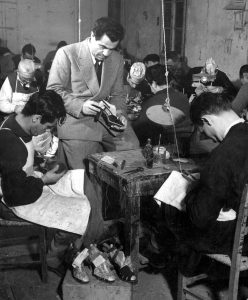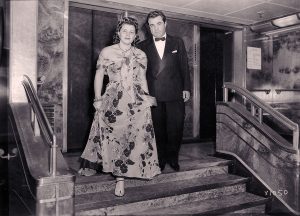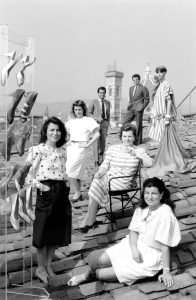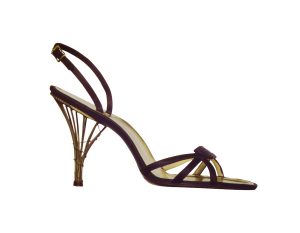Museo Salvatore Ferragamo Offers Insight Into The Celebrated Shoemaker’s Brilliance https://ift.tt/gSoeVtE
Museo Salvatore Ferragamo housed in the iconic Palazzo Spini Feroni in Florence, Italy remains one of the most visited and successful fashion museums in the world, independently owned and managed by the House. An ode to Ferragamo, whose original sketches and archival pieces adorn the walls, the site presents intimate photographs of the designer and his family, personal letters of gratitude from his most loyal clients including Princess Diana, and an ever-changing annual exhibit that reflects socially prevalent issues and voices of change playing a pivotal role in design today.

The museum acts as an active companion to the brand’s changing seasons rather than a silent reflection of the past, suggests its director Stefania Ricci, long-term friend of the Ferragamo family and one of the world’s most celebrated fashion historians. “There’s always been an appreciation for art and history, but we also wish to explore the modern issues and needs of women. The museum is the perfect bridge between past and present for the House,” she believes.

Ferragamo studied shoemaking in Naples and then journeyed to Santa Barbara where he set up a shoe repair shop with his brothers, later moving to the hills of Los Angeles where he opened ‘The Hollywood Boot Shop’. It was the beginning of cinema, which opened a plethora of new possibilities. His exploration of cowboy boots was perfect for movie actors,” elaborates Ricci. His very desire to expand, ironically, led him back home to Italy where production capabilities were easier to navigate.
Ferragamo was one of the first shoe designers to believe in an equal marriage of comfort and style spending hours with each client studying their foot to create the perfect sole. “Around 1916, he had enrolled for a course on foot anatomy at the University of Southern California for which he would travel 60 miles daily,” Ricci recalls. He was also one of the first shoe designers to champion sustainability—experimenting with cork, hemp, raffia and lace, owing to a leather shortage in Florence. The brand continues to uphold sustainability as a core value, upcycling materials and incorporating these into ready-to-wear collections. The Museo is also Italy’s first green corporate museum.

Whilst considered execution formed his approach to design, it was pure serendipity that led to Ferragamo and his wife Wanda’s love story in 1914. When he visited the house of his family doctor—whose daughter opened the door—it resulted in an instant attraction. Married the same year at 19 years old, Wanda was not only his closest confidante but later, the principal lens through which her husband’s vision was realised post his death in 1960. Before his passing, Ferragamo had nearly 20,000 designs piled in his studio, ready for transition from drawing board to workshop. Wanda brought many of her late husband’s dreams to life, one of the most noteworthy being the introduction of the house’s first women’s fragrance, Pour Femme, in 1998.

Ferragamo loved to play with heel heights. However, Wanda and their eldest daughter Fiamma emphasised comfort for women of all shapes, sizes and lifestyles. “Women were becoming dynamic and could not wear only high heels every day. His daughter introduced the Vara in 1978 with a three centimetre heel—perfect for working women who could wear the shoe to office. Later, the house launched the completely flat version, the Varina,” Ricci says.

One of Ferragamo’s most famous commissioned pieces in 1938 was for Maharani Indira Devi of Cooch Behar. The creation was a satin and kidskin sandal resting on a cork platform covered in velvet, with an appliqué of rhinestone-coated brass. His sentimental connection to the country extended from fascination to inspiration. Ricci elaborates, “He was heavily influenced by India and Indians—the colours, material combinations and people; it’s highly evident in the intricacies in his work.”
Nearly 70 years later, the house found its muse in the country again with Leonardo Ferragamo inviting Priyanka Chopra-Jonas to the Museo for a fitting, subsequently creating a one-of-a-kind silver snakeskin platform entirely crystallised with strass. Sonam Kapoor Ahuja and Abhishek Bachchan have since received customised shoes from the house as its relationship with the country deepens through the modernised perspectives of Salvatore’s children.
A polymath of sorts, Salvatore had the technical mind of an engineer, the aesthetic intuition of a creative visionary but more importantly the empathy and respect for women who played a fundamental role in transforming his life, heritage, and values to create the house of Ferragamo as it stands today.
Photographs courtesy: Museo Salvatore Ferragamo; David Lees
Find ELLE’s latest issue on stands or download your digital copy here.
from Elle India https://ift.tt/2Of3S0q
Comments
Post a Comment